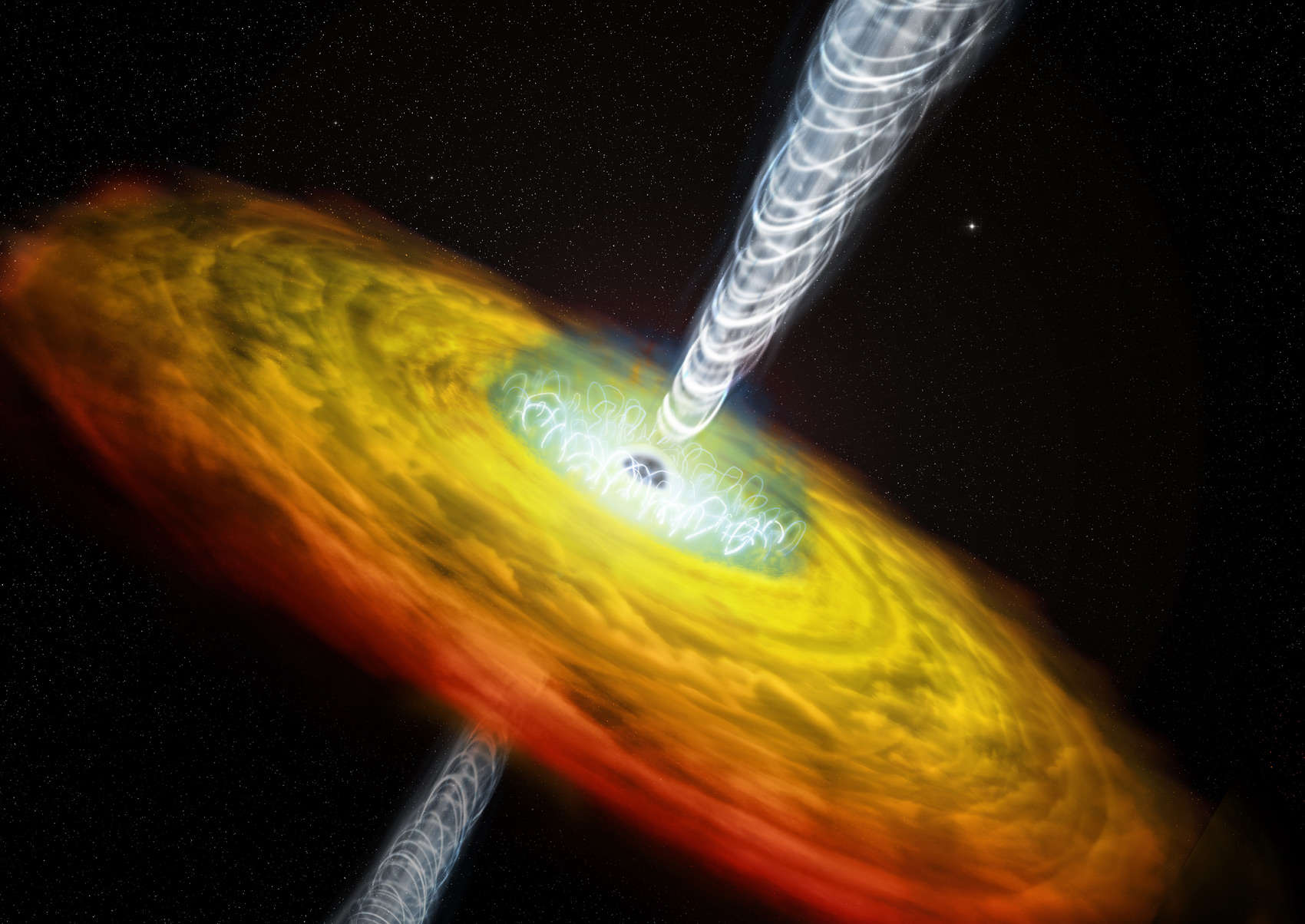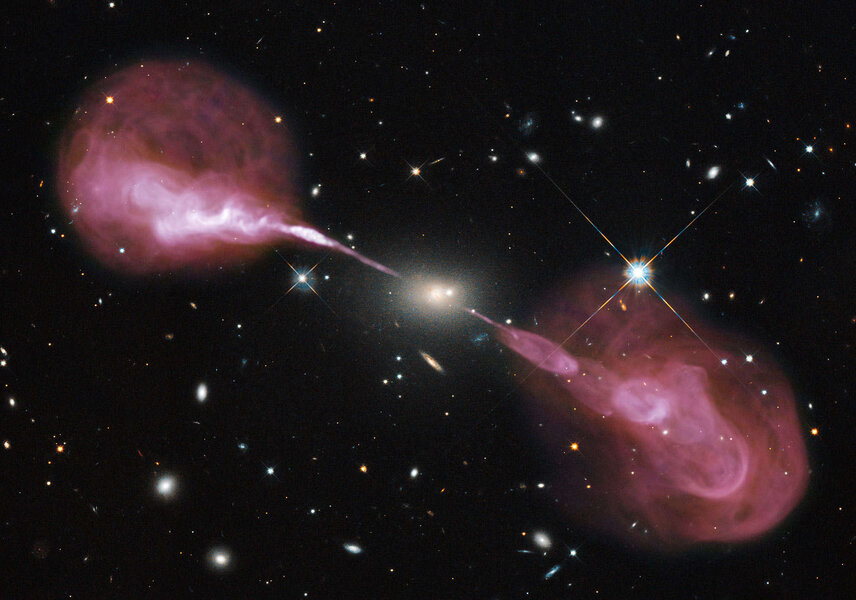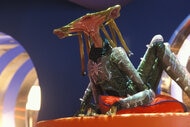Create a free profile to get unlimited access to exclusive videos, sweepstakes, and more!
How do supermassive black holes launch powerful jets of matter? With hot gas and magnetism.

The environment around a supermassive black hole is fairly complex.
Sitting in the centers of galaxies, that’s not too surprising. It’s crowded there, like being downtown in a big city at rush hour. But in this case it’s worse, because in a city you don’t have octillions of tons of material swirling around the city center at nearly the speed of light that has been heated to millions of degrees and blasts out vast amounts of energy making them the most powerful sources of radiation in the Universe.
Whereas supermassive black holes many times do. The disk is called an accretion disk, and conditions in it are difficult to understand. To make matters worse, sometimes these black holes and their disks somehow focus this energy and matter into twin beams, like a double light saber, that scream out at nearly the speed of light up and down, from the disk.
These beams, which astronomers call jets, contain energy across the electromagnetic spectrum from radio waves to X-rays. If that jet is pointed toward Earth, we can see all this radiation, and we call these types of objects quasars (or, if even super-high-energy light is seen, blazars). They’re phenomenally bright, and we can see them from billions of light years away, clear across the observable Universe.
These jets have a profound affect on the galaxy surrounding the black hole. They can push away gas in the galaxy center, suppressing star formation. They can also drive shock waves into gas farther out, encouraging the clouds to collapse and form stars. The growth of the black hole itself can depend on this as well, since it grows by feeding on that very gas.
So astronomers try to understand them, which can be difficult, since they’re so far away. But a new study, looking at a staggering 729 quasars, found a relation between quasars with jets and those without them, and it goes against the common model astronomers have used for decades.
The astronomers looked at the high-energy X-ray emission from the black holes. It’s well known that quasars without jets emit a certain amount of ultraviolet light (which comes from the inner disk), and that the X-ray emissions depend on that. If there’s more UV from a quasar we see more X-rays as well, and vice-versa.
The reason for this is thought to come from the black hole corona. This is extremely high-energy gas surrounding the accretion disk like a halo. UV photons from the disk hit the electrons in this corona gas and get boosted in energy, like how getting rear-ended by a truck can push a car forward. The result is the UV light gets boosted to X-ray energies. The more UV that’s emitted, the more X-rays you get.
Now, quasars with jets emit X-rays too, and moreover tend to be brighter (give off more X-rays) as well. It’s been thought that the X-rays come from the base of the jet, where magnetic fields get wound up into a vortex by all the swirling matter. This can focus the energy, which travels along the magnetic field lines. So they focus the jets, and the vast energies being wielded at the jet base are what cause the X-rays.
BUT. What the new study found is a similar relationship between X-rays and ultraviolet light as with quasars without jets. That implies a similar process, meaning the X-rays aren’t necessarily coming from the jet base, but from the black hole coronae! And, these coronae have strong magnetic field lines threading throughout them, which helps boost the energies emitted, which is why quasars with jets emit more X-rays than those without.
This is a big deal. The physics of the coronae is different than at the jet base, so this changes how we think the jets are launched. Mind you, these jets can extend for millions of light years, far larger than the host galaxy of the black hole! They’re enormous structures, so understanding how they get their start is critical.
As it happens, all quasars appear to need a rapidly spinning black hole in their hearts. The spin actually drags the fabric of spacetime around them, which affects the disk. It’s been thought that the jets depend on the black hole spin, but what the new study shows is that if the black hole corona is weak, you don’t get jets even if the black hole is spinning madly.
Again, that’s a big deal. That changes the standard way astronomers think of jets.
So the next question is, are these scientists right? Well, the trends they found do seem real, and compelling if not convincing. And they looked at a whole lot of quasars. I expect theorists who study the connection between black holes, their coronae, the magnetic fields, the disk, and the jets (phew!) will pounce on this idea eagerly, trying to see if they can figure out all the connections, and if they make sense. It’ll be interesting to see some exceptions to this rule can be found, too. That can really help, because sometimes quasars might have some weird characteristic that sets them apart, making the rules easier to understand by contrast (the idea of the exception that proves the rule*).
We know that the characteristics of entire galaxies depend on the properties of the black hole in their cores, even though the galaxy may have a million times the mass of that black hole. Clearly black holes are tiny but mighty, and how they power these jets is a big player in that game. Our own galaxy was once very likely a quasar, so in many ways we ourselves exist because of that fact. I think understanding how these work is an important piece of understanding how the Universe makes people. And I’m people, so I take this rather personally too.
And personally, I think all this is incredibly cool.
*In that link you’ll find different meanings of this phrase, and in this case I mean it in the sense of an exception that tests the rule under different circumstances, which can help support the general rule.
















